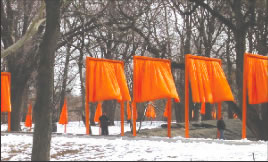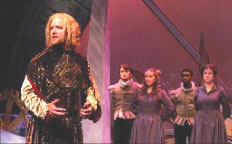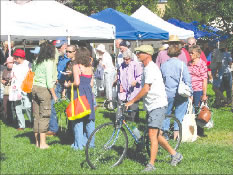by Keith Howard
Editors note: Christo’s proposed project for the Arkansas River, Over the River, has generated passionate discussion since its conception and much has been written for and against the project.
We decided to take a look at the career of the controversial artist, his works, and the challenges of displaying public art on such a vast scale.
It was an astonishing spectacle.
Enormous yellow umbrellas were stretched out before me in all directions, planted sporadically in the open fields, lining the interstate, marching down the ridges of the hills. Television crews were clambering out of trucks, reporters with clean shoes were pacing around, looking for people to interview. When the microphone came around to me I didn’t have the presence of mind to stare into the camera and say the only correct thing: “Get your carcass off the couch and get up here and see this thing; you’ll never forgive yourself if you don’t.”

It was October 9, 1991. I’d been hired with a thousand other people to unfurl Christo’s Umbrellas project in the mountains north of Los Angeles. I’d been on-site for a week, and being surrounded by a Christo project had convinced me utterly of the viability of his work. I’d felt quite specifically that something important was about to happen, a charge in the air, so to speak. When the units started billowing open that morning, I realized I was looking at something of singular importance, an arrangement of forms in the landscape that was redefining what art could be. The reach of the umbrella units to the hills a couple of miles away changed my perception of distance – the entire valley felt close, intimate, and innocuously playful. Over the course of the day I observed several specific things, including:
• A succession of three umbrellas planted like signposts at the curves of a winding two lane road that shrunk it, visually, and transformed it into something resembling a Japanese footpath.
• An umbrella jammed up against the side of the post office, gently mocking the little one story brick structure.
• An umbrella planted impudently on an entrance ramp to the freeway, the tractor trailers rumbling under its shadow as they made their way to the highway.
• Another umbrella settled in the midst of a fast-food cluster that made the little burger joints look so incongruous against the landscape that one wanted to summon a bulldozer.
• Lines of umbrellas a mile long, marching down from opposing hills to meet in the middle of the valley, but thwarted in the middle by the concrete gash of Interstate 5. It looked for all the world like two lovers straining to reach one another across an impassable boundary.
What I saw that day kindled a protracted interest in Christo’s career.
Christo joined a handful of people who escaped on a boxcar from behind the Iron Curtain in January 1957, on the heels of the massive displacement of refugees following the Soviet suppression of the Hungarian uprising of November 1956. He floated around Austria and Switzerland for the better part of a year before winding up in Paris, where he met his wife, Jeanne-Claude, and quickly established himself among the avant-garde artists in that city, a group that came to be dubbed the New Realists. These were an adventurous and picaresque bunch. The putative leader, Yves Klein, sought to demonstrate the death of easel painting by coating his canvases uniformly with blue paint, applied with a roller and pan- the tools one would use to paint the bathroom. When he painted the nude, he painted the nude: he dipped the naked model in blue paint and directed her to roll around on a blank canvas.
The artist Arman created glass-box assemblages of household garbage and displayed them in galleries, being careful not to include anything that would decompose and foul the exhibition space. The Swiss artist Jean Tinguely created elaborate machines that automatically produced “art,” or destroyed themselves in a flourish of smoke and controlled explosions. Niki de Saint Phalle incorporated packets of pigment into her canvases and then “painted” by shooting these bulging bits of color with a .22 caliber to have them stream down the painting like blood from a wounded animal.
For Christo to emerge from a Communist bloc country and in almost no time establish himself among the iconoclast artists of Paris was a breathtaking accomplishment. It is a measure of his ambition that he regarded this achievement as a waymark to bigger things. In 1961 he created his first proposal for wrapping a public building; serving notice to the Parisian authorities that they would be contending with an artist working at an enormous scale. He created a piece shortly afterward that stepped into the realm of civil disobedience. He stacked a truckload of empty oil drums to block off a very narrow Paris street, sans permit. It was titled Iron Curtain, created in response to the sectioning of Berlin, underway at the behest of the Soviets. This was more than a traditional art work; it was an event. It was in step with the developing movement of performance art in New York and several cities in Europe, where a public place was “occupied” by artists who performed carefully scripted demonstations, or staged more spontaneous events that drew upon unpredictable contributions from the public.
This element of overt participation with the public, sometimes to its discomfiture, is a crucial element of Christo’s work, and his projects cannot be fairly evaluated without taking this mechanism into account. Trying to assess his projects without analyzing this public dynamic is like trying to write a review of an opera by listening to it on the radio.
Christo and Jeanne-Claude moved to New York in 1964, and in a few short years completed a number of major projects, both overseas and in the U.S., including Valley Curtain, 1971-72. His masterpiece, Running Fence, was completed in 1976, and ran 24 miles over agricultural land north of San Francisco. The 18 foot white fence, careening across rolling hills and suburbs and dairy farms and eventually plunging into the Pacific Ocean, redefined the landscape and by many accounts transformed the land itself into a work of art. It caused the observer to think on an entirely new scale. A fence that stretched from one horizon and then disappeared into the ocean implied an object that wrapped around the whole planet. It changed one’s perception of space and created a work of art that dwarfed the observer while it went hurtling off to a distant horizon.
Public participation in Running Fence took the form of concerted and vitriolic opposition to the project; cost overruns mounted as boards of supervisors fretted over the objections from the local populace. “Everybody likes a good fight now and then,” observed Larry Silacci, one of the ranchers whose land was crossed by the Fence. The county’s predisposition to deny a permit for the project angered the many farmers who had, after some protracted discussion by Christo and Jeanne-Claude, agreed to allow the fence onto their properties. He says, “You just can’t tell a bunch of farmers that they can’t do something . . . Christo’s battle became our battle.” The necessity of involving the public in the event, established with his first project, Iron Curtain, confirmed itself in unpredictable ways with the difficulties that attended the completion of Running Fence. Larry’s wife, Christy Silacci, explained, “I always felt sorry for Christo, because he had to go through so much. And one day he said to me, ‘This is the whole thing. It’s not just putting up this Running Fence, it’s the process.’ He was thrilled going to court, or going before the county. He was thrilled when people would put up obstacles… the hard parts of it were just as important to him as putting up the fence.”
The capacity to contend patiently with the impediments thrown in the way of a project is clearly necessary. Some have taken a very long time. The Wrapped Reichstag, first proposed in the early 70s, took until 1995 to be completed. (All that was really required was the collapse of the Soviet Union and the demise of the Berlin Wall.) Originally the seat of parliament in Nazi Germany, the building later stood at the demarcation line between East and West Berlin, a chess piece in the geopolitical context of the Cold War. Its wrapping was attended by a celebratory tone that the millions of visitors embodied as a tribute to the passing of the political shadow that had hung over Germany for so long.
The Gates project for Central Park had a similar role in celebrating the resilience and pluck of the city that had suffered the attack of Sept 11. Opened in February 2005, the miles of footpaths straddled by thousands of bright orange uprights and swaying fabric panels created a noticeable lift in the demeanor of the hard-bitten citizens of New York, a buoyancy that turned out to be an essential component of the whole undertaking. The elaborate and carefully sculpted terrain of Central Park was threaded and woven with lines of bright color that were visible through the barren branches of the winter trees. The Park had been built in the 1860s as a kind of relief valve for the social pressures building up in Manhattan. The Gates took this function and added to it the focused uplift of a population still laboring under the legacy of what had been lost in 2001.
The Gates also brightened the financial outlook of the city, bringing an extra $250 million dollars of tourist money to the local economy during the typically slow month of February. This was part of the deal struck with Michael Bloomberg, today still the mayor of New York. An old friend and collector of Christo’s work, Bloomberg swept away years of bureaucratic hostility to the Gates project and put it on a fast track for completion. This speaks to an aspect of the career of Christo and Jeanne-Claude that is a salient factor in the debate on the Over the River project in Salida and the small towns running east along the river – political power. Their years of success in realizing ambitious and highly publicized art events have made Christo and Jeanne-Claude into stars. The list of wealthy collectors and powerful political figures they have dealt with personally is formidable. It is inevitable that this couple, determined and skilled at realizing these projects, should find increasingly efficient ways to get them done. The ironic result is that on occasion their efforts resemble in language and tone the very bureaucracies they have long striven against.
It is likely that Over the River, if it goes, will have some remarkable effects both in the day-to-day life of the canyon and in the visual panoramas it presents. One of the strongest features of the project is likely to be an elucidation of how we have treated, or rather, mistreated, the canyon over the years. The addition of the railroad grade and the very extensive grading necessary for the building of U.S. 50, are likely to appear more out of place, more insensitive to the beauty of the landscape. It is probably no accident that a portion of the canopy will span between undisturbed areas on one side of the river and huge hillsides that have been shorn of all features to accommodate the road. What we take for granted as an acceptable concession to commerce may look a bit more like something of a shame. And typical for any Christo project, there will be things that happen that nobody could have foreseen.
Keith Howard is an artist writing from Denver, where he observes the American suburbs.


